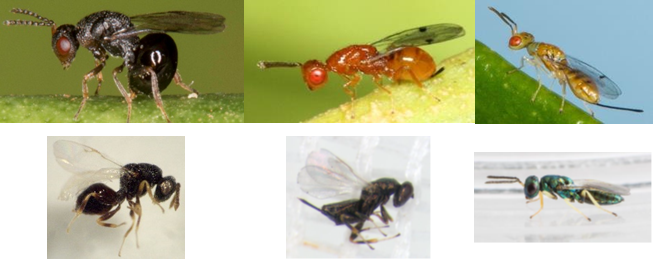16 July 2021
Assessing potential enemies of the citrus gall wasp
Assessing potential enemies of the citrus gall wasp
16 July 2021
Lucerne interplanting (Figure 1) is practised by some citrus growers to suppress weeds, reduce soil compaction and improve soil fertility.

Figure 1. Lucerne planted between citrus rows.
It was recently reported that lucerne interplanting improved the control of the citrus gall wasp (CGW). One possible explanation is that lucerne enhanced the biological control of CGW.
Lucerne seeds are attacked by a gall-forming wasp closely related to CGW, the lucerne seed wasp (LSW). Adult LSW looks very similar to adult CGW and, like CGW, LSW is attacked by a suite of parasitic wasps, at least two of which are present in Australia (Figure 2).

Figure 2. Top – Citrus gall wasp (left) and its parasitic wasps (middle and right); Bottom – Lucerne seed wasp (left) and its parasitic wasps (middle and right).The assumption was that parasitic wasps of LSW also attacked CGW. We posed the question: Does such cross-species parasitism really occur?
To answer the question, we investigated CGW parasitism on a farm in central west NSW, where the benefit of lucerne interplanting for CGW control was reportedly observed.
Despite being in a historically high CGW infestation region, this farm had not seen any citrus galls until the summer of 2019, 10 years after its establishment.
The farm has 20 hectares of Hamlin orange on the Trifoliata rootstock and 20 hectares of Pineapple orange on the Citrange rootstock. Lucerne was planted in two out of every three rows throughout the farm.
A total of 844 galls were randomly collected from citrus foliage in a 14ha Pineapple block, a 5ha Pineapple block and a 13ha ‘Hamlin’ block on the farm in late October 2020.
A total of 28,612 CGW adults and 3,754 parasitic wasps emerged from these galls. Random dissection of the galls revealed 11,755 un-emerged CGW adults and 466 un-emerged parasitic wasps, bringing the total number of CGW adults to 33,617 and that of the parasitic wasps to 4,220.
The overall parasitism level was about 11%. The parasitic wasps were exclusively Megastigmus brevivalvus, the primary parasitic wasp species of CGW in Australia. No known parasitic wasps of LSW were recovered.
In addition to parasitic wasps, we checked CGW infestation in the 14ha Pineapple block. We found similar CGW infestation levels between citrus rows next to lucerne plantings and citrus rows not next to lucerne plantings.
We did a sweep-net sampling in the same block on a later date when the seed pods were available. We did not find any known parasitic wasps of either the LSW or CGW.
We also collected over 1500 lucerne seed pods and reared them for wasp emergence. No known parasitic wasps of LSW emerged from the seed pods.
In summary, we did not rear any parasitic wasps of LSW from CGW galls, neither did we see reduced CGW infestation in citrus rows next to lucerne plantings.
We do not rule out the possibility of parasitic wasps of LSW parasitising CGW, however, the chances of finding such cross-species parasitism are low.
Most parasitic wasps only attack their own hosts. In addition, parasitic wasps of LSW and CGW emerge at different times of the year, further reducing chances of cross-species parasitism.
Jianhua Mo is a research entomologist with NSW DPI. He can be contacted on Jianhua.mo@dpi.nsw.gov.au

Membership
You are not logged in
If you are not already a member, please show your support and join Citrus Australia today. Collectively we can make big things happen.
